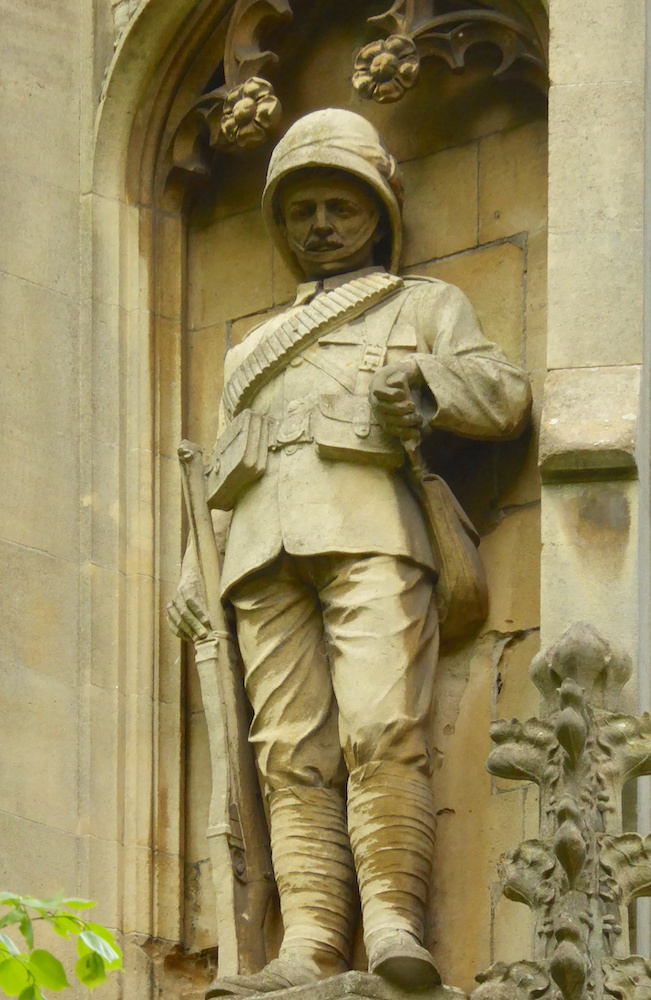Thanks to Ian Drake, Keeper of the Evelyn Collection, YAYAS (Yorkshire Architectural and York Archaeological Society) for allowing us to reproduce the historic photographs here. Note that they should not be reproduced without written permission. The other photographs were taken by the author, and may be used without prior permission for any scholarly or educational purpose as long as you (1) credit the photographer and (2) link your document to this URL in a web document or cite the Victorian Web in a print one. [Click on the images to enlarge them.]


Boer War Memorial: whole view, and detail, with the crowned cross keys heraldic device for the Diocese of York at the top. Designed by G. F. Bodley (1827-1907), the superintendent architect for York Minster and Peterborough. Within the ecclesiastical sphere, Bodley designed for many different mediums, and the architectural aspect of the memorial was a fine opportunity for him to express his love of the Gothic. This was especially appropriate here because of its proximity to the Minster.
The memorial, which was executed by Messrs Bridgeman of Lichfield, was unveiled on 3rd August 1905. Nikolaus Pevsner and David Neave say “it is the type of the Eleanor Crosses only much, much bigger” (215): it is 37ft high according to the Yorkshire Post, or 40 feet high according to the war memorials register (see "Yorkshire — Boer War"). It is in Ketton stone with blue-green Cumberland slate for the inscription panels. The octagonal memorial with its surrounding lawn and trees took the last vacant space in Duncombe Place, a grand approach to the Minster conceived in the 1860s. It is on the south-east side of the Place, at the top nearest the Minster, and is Grade II* listed.




Left to right: (a) Arrangement of the figures, with the Imperial Yeoman on the right. Note the gargoyles, crocketed pinnacles and other Gothic features. (b) The Sailor with his grappling iron. (c) The Cavalryman (spurs just visible). (d) The Artillery Man (with his cannon loader).
Both the Yorkshire Post and Intelligencer account of the unveiling, and the Imperial War Museum's site, list the eight standing figures as: a sailor, cavalryman, artilleryman, infantryman, member of the Imperial Yeomanry, militiaman, volunteer and nurse. The recent photographs were taken beginning with the sailor, who faces the entrance to the grassed area from Duncombe Place, then anti-clockwise round the monument; the third position being empty due to the lightning strike of 1961 (see below). Note that the order of the photographs and the statuary is not that of the texts, which put the nurse last. She is opposite the sailor in the fifth position, at the rear, least visited side, of the monument, so again, takes the inferior position.




Left to right: (a) Nurse. (b) Militiaman (probably), holding a baton. (c) Infantryman (probably), with water-bottle carrier. (d) Imperial Yeoman, with his greatcoat and his head lowered.
The unveiling ceremony was performed by Lord Roberts, the last person to hold the office of Commander-in-Chief of the Forces. The statuary was not yet complete, but the Yorkshire Post of 4 August lists the figures and the names of their various donors. The site was given by the Little Blake Street Improvement Committee; there were 231 subscribers. Mr Frank Green, mentioned as active in the preparations, is the man who created the Treasurer’s House (now managed by the National Trust) out of three separate houses on the far side of the Minster.
The main panel reads as follows:
Remember those loyal and
gallant soldiers and sailors
of this County of York who
fell fighting for their country’s
honour in South Africa 1899 to
1902 and whose names are
inscribed on this Cross Erected
by their fellow Yorkshiremen
A.D. 1905


These photographs are reproduced by courtesy of YAYAS Evelyn Collection, and are not to reproduced without written permission. See bibliography for link to the site.
An early twentieth-century photograph in the Evelyn Collection of the top of Duncombe Place shows the memorial complete. Both the cross finial and the standing figure that were lost in a lightning strike in 1961 can be seen in this view: there is now an efficient lightning conductor, as can be seen in the top righthand photograph.
There are thought to be 1459 names inscribed on it, under regiment and rank. The many regiments listed are not all Yorkshire ones, since, for example, one of the dead was a Private in the South Wales Borderers, and two were Privates in the Royal Welsh Fusiliers. But the personnel were all from the county. The dead listed were mostly in the army, including a bandsman, two drummers and a bugler, but also sailors and military nurses, who were killed or died of disease (see "Yorkshire — Boer War").
Related Material
- The Eleanor Cross in London (for comparison)
- The Boer War (includes links to other Boer War memorials)
Bibliography
Pevsner, Nikolaus, and David Neave. Yorkshire: York and the East Riding. New Haven and London: Yale University Press, 2002.
Yorkshire — Boer War. Imperial War Museum. Web. 4 June 2021.
Yorkshire Post. 4 August 1905: 4.
Created 4 June 2021